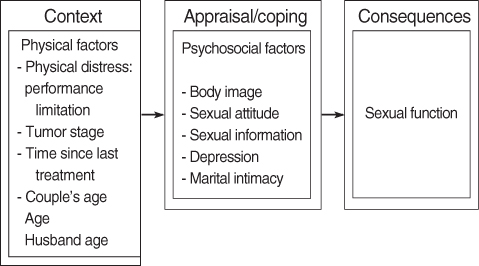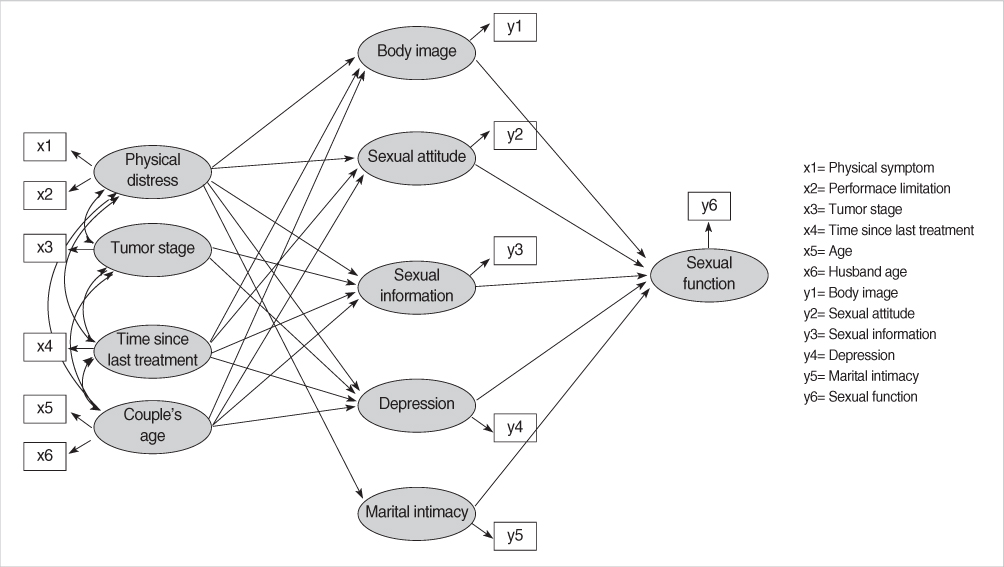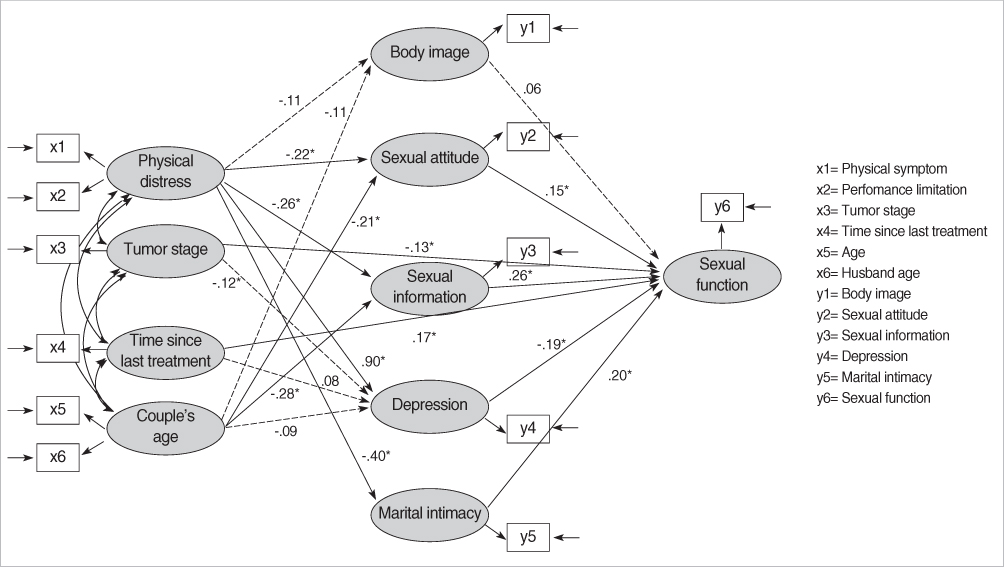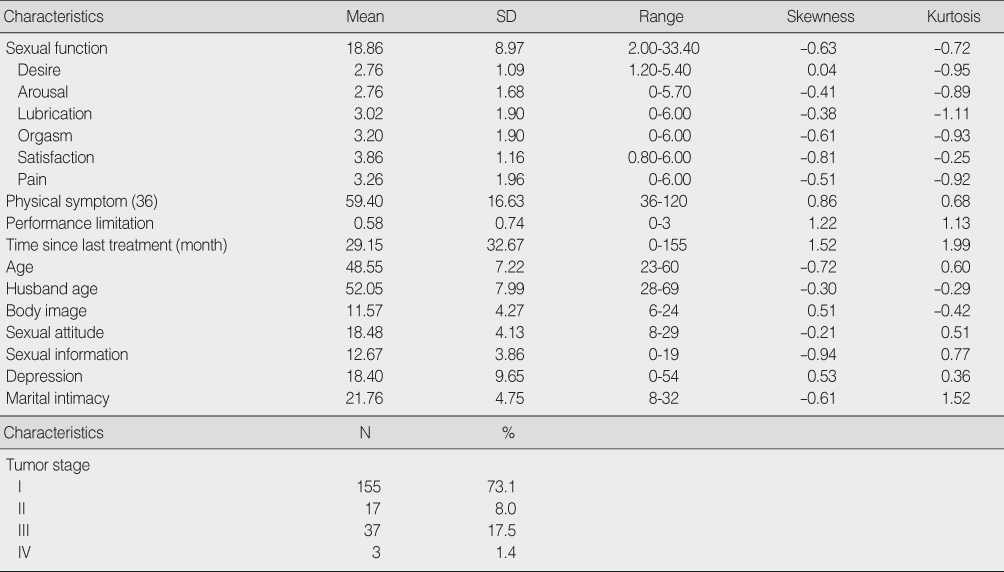Articles
- Page Path
- HOME > J Korean Acad Nurs > Volume 38(5); 2008 > Article
-
Original Article
- A Structural Equation Model on Sexual Function in Women with Gynecologic Cancer
- Nami Chun
-
Journal of Korean Academy of Nursing 2008;38(5):639-648.
DOI: https://doi.org/10.4040/jkan.2008.38.5.639
Published online: October 30, 2008
Full-time Instructor, College of Nursing, Sungshin Women's University, Seoul, Korea.
- Address reprint requests to: Chun, Nami. College of Nursing, Sungshin Women's University, 249-1 Dongseon-dong 3-ga, Seongbuk-gu, Seoul 136-742, Korea. Tel: 82-2-920-7523, Fax: 82-2-920-2902, nmchun@sungshin.ac.kr
• Received: July 21, 2008 • Accepted: September 5, 2008
Copyright © 2008 Korean Society of Nursing Science
Abstract
-
Purpose
- This study was designed to construct and test a structural equation model on sexual function in women with gynecologic cancer.
-
Methods
- The model was constructed and tested under the hypotheses that women's physical changes in sexual function after gynecologic cancer treatment did not automatically lead to sexual dysfunctions. Women's psychosocial factors were considered to be mediating variables. Two hundred twelve women with cervical, ovarian, and endometrial cancer were recruited and asked to complete a survey on their physical factors, psychosocial factors and sexual function. Data was analyzed using SPSS WIN 12.0 and Amos WIN 5.0.
-
Results
- Predictors of sexual function in the final model were sexual attitude affected by physical distress and couple's age, sexual information affected by physical distress and couple's age, depression affected by physical distress, and marital intimacy affected by physical distress. Tumor stage and time since last treatment directly affected women's sexual function without any mediating psychosocial variables. However, body image did not affect women's sexual function.
-
Conclusion
- Nursing professionals should develop a tailored educational program integrating both physical and psychosocial aspects, and apply it to women and their spouses in order to promote sexual function in women with gynecologic cancer.
- 1. Bae J, Min K, Ahn S. Construction of an explanatory model of female sexual dysfunction. Journal of Korean Academy of Nursing. 2007;37:1080–1090.ArticlePubMedPDF
- 2. Bae JY. A study on female sexual dysfunction, sexual distress, sexual attitude and knowledge in Korean women. Korean Journal of Women Health Nursing. 2004;10:342–350.ArticlePDF
- 3. Carmack Taylor CL, Basen-Engquist K, Shinn EH, Bodurka DC. Predictors of sexual functioning in ovarian cancer patients. Journal of Clinical Oncology. 2004;22:881–889.ArticlePubMed
- 4. Chang SB. An analytic study on influencing factors for sexual satisfaction in women who have had a hysterectomy. Journal of Korean Academy of Nursing. 1989;19:160–172.ArticlePDF
- 5. Chang SB, Jeong SE. Pre-post changes of sexual satisfaction and spouse support of women who have had a hysterectomy. Journal of Korean Academy of Nursing. 1995;25:173–183.ArticlePDF
- 6. Chon KK, Rhee MK. Preliminary development of Korean version of CES-D. The Korean Journal of Clinical Psychology. 1992;11:65–76.
- 7. Chun N, Kwon JY, Noh GO, Kim SH. Symptom clusters in women with gynecologic cancer. Journal of Korean Clinical Nursing Research. 2006;14:61–70.
- 8. Chun N, Park YS. Sexual functioning in women with gynecologic cancer. Korean Journal of Women Health Nursing. 2006;12:308–315.ArticlePDF
- 9. Derogatis LR, Meyer JK, Vazquez N. A psychological profile of the transsexual. I. The male. Journal of Nervous and Mental Disease. 1978;166:234–254.ArticlePubMed
- 10. Ell K, Sanchez K, Vourlekis B, Lee PJ, Dwight-Johnson M, Lagomasino I, et al. Depression, correlates of depression, and receipt of depression care among low-income women with breast or gynecologic cancer. Journal of Clinical Oncology. 2005;23:3052–3060.ArticlePubMed
- 11. Jensen PT, Groenvold M, Klee MC, Thranov I, Petersen MA, Machin D. Longitudinal study of sexual function and vaginal changes after radiotherapy for cervical cancer. International Journal of Radiation Oncology, Biology, Physics. 2003;56:937–949.ArticlePubMed
- 12. Jensen PT, Groenvold M, Klee MC, Thranov I, Petersen MA, Machin D. Early-stage cervical carcinoma, radical hysterectomy, and sexual function. A longitudinal study. Cancer. 2004;100:97–106.ArticlePubMed
- 13. Juraskova I, Butow P, Robertson R, Sharpe L, McLeod C, Hacker N. Post-treatment sexual adjustment following cervical and endometrial cancer: A qualitative insight. Psycho-Oncology. 2003;12:267–279.ArticlePubMed
- 14. Kim HJ. Comparison of the level of marital intimacy according to the level of stress among middle-aged women. The Korean Society of Maternal and Child Health. 2001;5:123–136.
- 15. Kim JH, Moon HS. Helth perception, body image, sexual function and depression in menopausal women according to menopausal stages. Journal of Korean Academy of Nursing. 2006;36:449–456.PubMed
- 16. Kim GS. Analysis of structural equation model. 2007;Seoul, Hannarae Publishing.
- 17. Kim SN. A structural model for quality of life in women having hysterectomies. Journal of Korean Academy of Nursing. 1999;29:161–173.ArticlePDF
- 18. Kim YO. Change in sexual life after primary radiotherapy in patients with cervical carcinoma. 1991;Seoul, Yonsei University. Unpublished master's thesis.
- 19. Lim HS, Yoo EK. A comparative study on sexual life between women and their spouses after hysterectomy. Korean Journal of Women Health Nursing. 2003;9:189–200.ArticlePDF
- 20. Lee IS, Moon JS. Knowledge of sex, attitude toward sex, and sexual satisfaction in married women. Journal of Korean Academy of Public Health Nursing. 2000;14:396–414.
- 21. Oken MM, Creech RH, Tormey DC, Horton J, Davis TE, McFadden ET, et al. Toxicity and response criteria of the Eastern Cooperative Oncology Group. American Journal of Clinical Oncology. 1982;5:649–655.ArticlePubMed
- 22. Petersen RW, Graham G, Quinlivan JA. Psychologic changes after a gynecologic cancer. Journal of Obstetrics and Gynaecology Research. 2005;31:152–157.Article
- 23. Radloff LS. The CES-D scale: A self-report depression scale for research in the general population. Applied Psychological Measurement. 1977;1:385–401.ArticlePDF
- 24. Rosen R, Brown C, Heiman J, Leiblum S, Meston C, Shabsigh R, et al. The female sexual function index (FSFI): A multidimensional self-report instrument for the assessment of female sexual function. Journal of Sex & Marital Therapy. 2000;26:191–208.Article
- 25. Stewart DE, Wong F, Duff S, Melancon CH, Cheung AM. "What doesn't kill you makes you stronger": An ovarian cancer survivor survey. Gynecologic Oncology. 2001;83:537–542.ArticlePubMed
- 26. Waring EM, Reddon JR. The measurement of intimacy in marriage: The waring intimacy questionnaire. Journal of Clinical Psychology. 1983;39:53–57.ArticlePubMed
- 27. Weijmar Schultz WC, Van de Wiel HB, Hahn DE, Bouma J. Psychosexual functioning after treatment for gynecololgical cancer: An integrative model, review of determinant factors and clinical guidelines. International Journal of Gynecological Cancer. 1992;2:281–290.ArticlePubMed
- 28. Wiegel M, Meston C, Rosen R. The female sexual function index (FSFI): Cross-validation and development of clinical cutoff scores. Journal of Sex and Marital Therapy. 2005;31:1–20.ArticlePubMed
- 29. Wilmoth MC, Spinelli A. Sexual implications of gynecologic cancer treatments. Journal of Obstetric, Gynecologic, and Neonatal Nursing. 2000;29:413–421.Article
- 30. Yu HS. Predictors of female sexual dysfunction. 2003;Seoul, Seoul National University. Unpublished master's thesis.
REFERENCES
Figure & Data
REFERENCES
Citations
Citations to this article as recorded by 

- Development and Evaluation of a Sexual Health Improvement Program for Women with Gynecologic Cancer
Soon Yang Jang
Asian Oncology Nursing.2021; 21(3): 163. CrossRef - Factors Affecting the Sexual Function of Pregnant Women
Eun Jung Oh, Moon Jeong Kim
Korean Journal of Women Health Nursing.2019; 25(1): 73. CrossRef - Quality of Life by Stage of Cervical Cancer among Malaysian Patients
Mohammed Nawi Azmawati, Endut Najibah, Mohd Dali Ahmad Zailani Hatta, Ahmad Norfazilah
Asian Pacific Journal of Cancer Prevention.2014; 15(13): 5283. CrossRef - Effect of PLISSIT Model Sexual Health Enhancement Program for Women with Gynecologic Cancer and Their Husbands
Ju-Hee Nho
Journal of Korean Academy of Nursing.2013; 43(5): 681. CrossRef - A Study on the Predictive Factors of Sexual Function in Women with Gynecologic Cancer
Jeong Sook Park, Soon Yang Jang
Asian Oncology Nursing.2012; 12(2): 156. CrossRef - Descriptive Study on Sexuality for Women with Gynecological Cancer
Ju Hee Nho, Young Sook Park
Korean Journal of Women Health Nursing.2012; 18(1): 17. CrossRef - Effect of Depression and Anxiety on Symptoms in Thyroid Cancer Patients Undergoing Radioactive Iodine (I131) Therapy
Nami Chun
Asian Oncology Nursing.2012; 12(4): 297. CrossRef - Effectiveness of PLISSIT Model Sexual Program on Female Sexual Function for Women with Gynecologic Cancer
Nami Chun
Journal of Korean Academy of Nursing.2011; 41(4): 471. CrossRef - Predictors of Sexual Desire, Arousal, Lubrication, Orgasm, Satisfaction, and Pain in Women with Gynecologic Cancer
Nami Chun
Journal of Korean Academy of Nursing.2010; 40(1): 24. CrossRef
A Structural Equation Model on Sexual Function in Women with Gynecologic Cancer



Figure 1
Conceptual framework.
Figure 2
The hypothetical model.
Figure 3
Path diagram for the modified model.
Figure 1
Figure 2
Figure 3
A Structural Equation Model on Sexual Function in Women with Gynecologic Cancer
Descriptive Statistics of Observed Variables (N=212)
Correlations among Observed Variables
*p<.05; **p<.01.
x1=physical symptom; x2=performance limitation; x3=tumor stage; x4=time since last treatment; x5=age; x6=husband age; y1=body image; y2=sexual attitude; y3=sexual information; y4=depression; y5=marital intimacy; y6=sexual function.
Table 1
Descriptive Statistics of Observed Variables (N=212)
Table 2
Correlations among Observed Variables
*p<.05; **p<.01. x1=physical symptom; x2=performance limitation; x3=tumor stage; x4=time since last treatment; x5=age; x6=husband age; y1=body image; y2=sexual attitude; y3=sexual information; y4=depression; y5=marital intimacy; y6=sexual function.
 KSNS
KSNS
 E-SUBMISSION
E-SUBMISSION





 Cite
Cite

